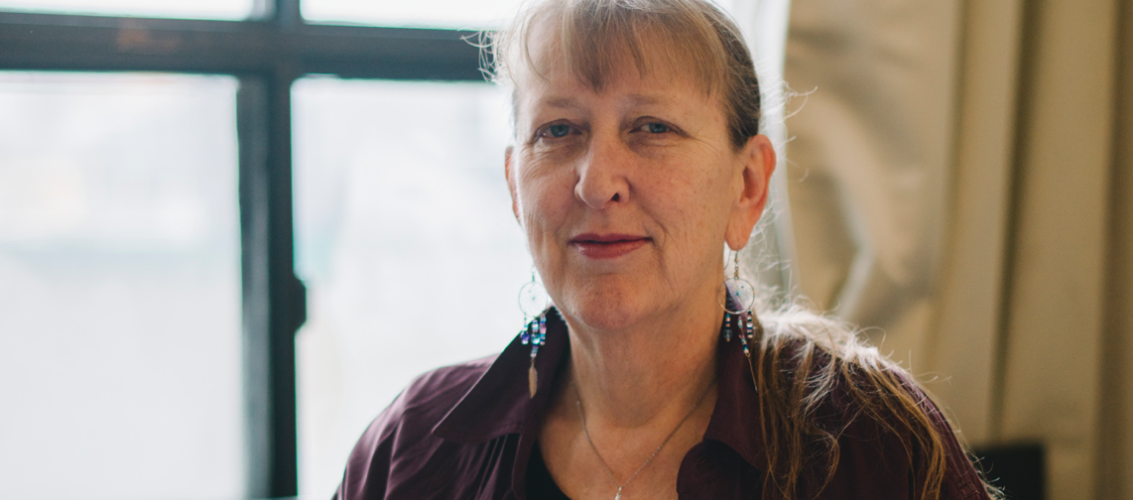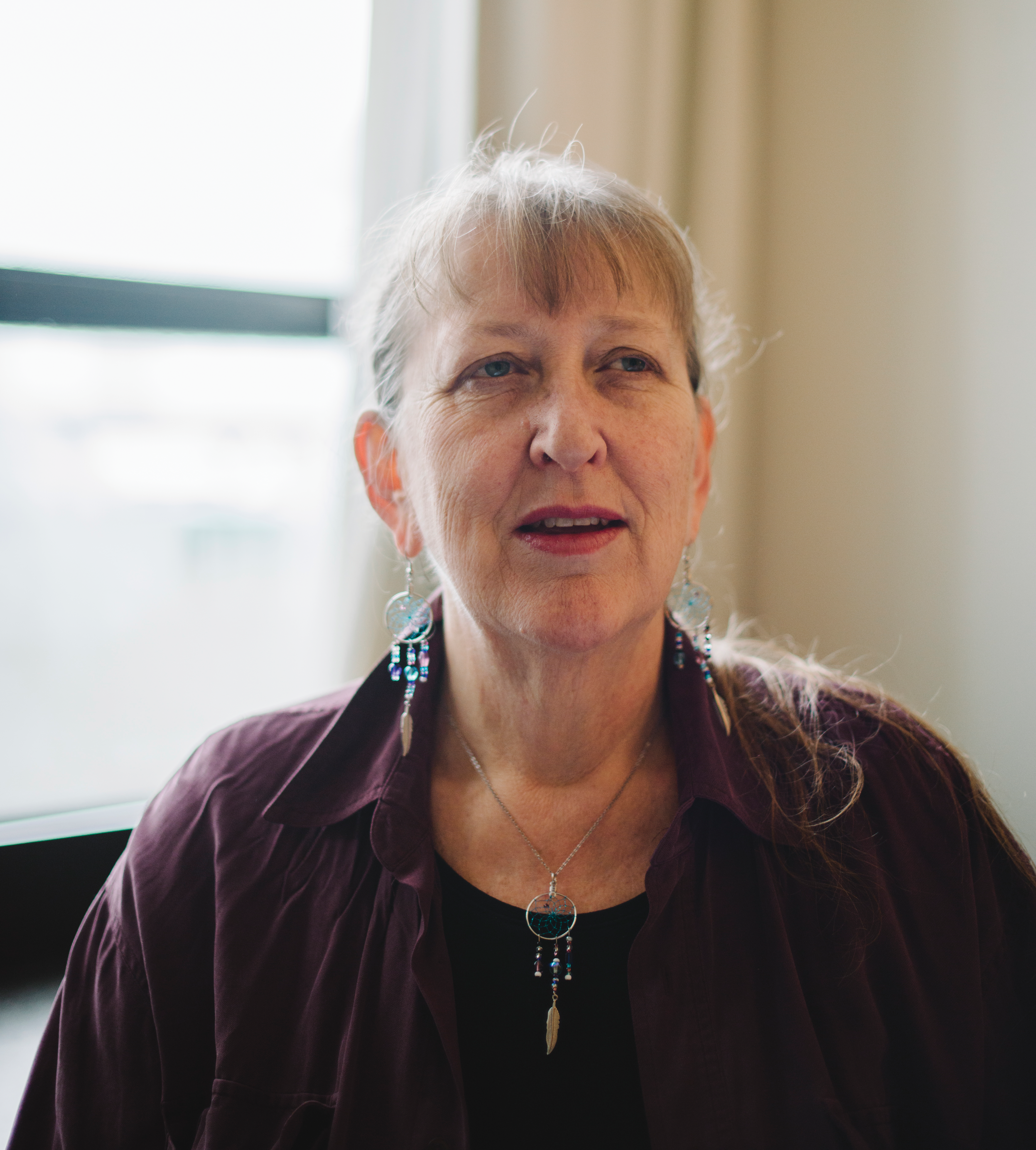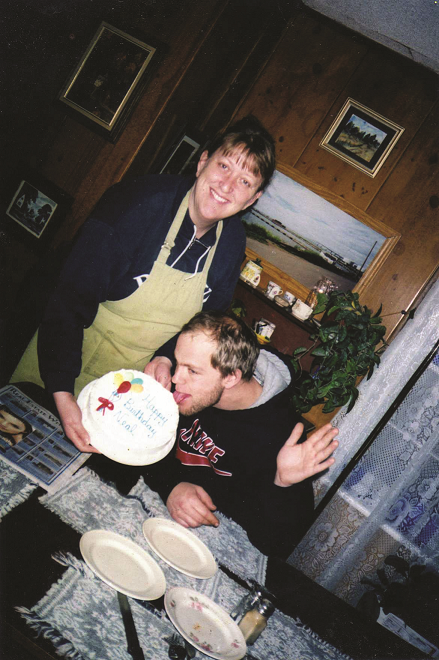
Marilyn Muir never expected to escape Vancouver Island alive.
The RN and mother of two, then 31, says she was abused and isolated by her partner, and was warned, if you leave, I will kill you.
But despite the threat, or perhaps, because of it, Muir decided one spring night in 1991 to flee, waiting for her partner to fall asleep on the couch, then rousing her nine-year-old son Neal and two-year-old daughter.
She fled her home without legal identification, something she says her partner kept from her, and with little money; Muir says her partner demanded she cash work cheques and turn over the money to him.
Needing to cash her last cheque the coming morning at Royal Jubilee Hospital in Victoria, Muir drove to a motel on that city’s outskirts. Later that night, her partner phoned the motel and asked if Muir and her kids were there. The person at the front desk lied and then told the nurse about the call.
That morning, a panicked Muir drove to the hospital, cashed her last cheque, then set out to drive four-and-a-half kilometres to the ferry.
“I really didn’t think I’d make it. I thought he was going to get me,” she says.
Her flight from violence was not her first, she says. As an adopted child living on a farm near Barrie, Ontario, Muir says she was physically abused by the man who adopted her. That trauma left her seeking solace in alcohol and drugs. By age 12, Muir, who would grow to a statuesque 6’1”, was getting into bars, smoking pot and dropping acid.
At age 18 or 19, she took money meant for college and bought a one-way bus ticket to Vancouver.
Decades later, looking back at her mad dash to the ferry, Muir doubts she would have fled if it wasn’t for her children.
“I don’t know if I would have done it just for me. I did it just for them.”
She thought she was delivering her children to safety, and for many years, that was the case. But an insidious harm later would cast its shadow.
In recent years, it was the growth of an opioid epidemic that prompted RNAO to lend its voice to victims, advocating for changes that reduce harm and provide supervised injection services (SIS). These efforts included a cover feature in the September/October 2016 Journal and a best practice guideline (BPG) in early 2018. RNAO’s advocacy paved the way for SIS in as many as 21 sites across Ontario, including locations in Guelph, Hamilton, Kingston, London, Niagara, Ottawa, Thunder Bay and Toronto.
Despite that advocacy, the death toll continues to climb. From July 2017 to June 2018, the last full year for which data is available in Ontario, 1,354 people in this province died from opioid-related causes, according to preliminary figures reported by Public Health Ontario. Over those same 12 months, opioids sent 8,567 to an Ontario emergency department.
Muir lived those stats. From 2009 to 2018, she worked at Royal Victoria Hospital in Barrie as an emergency access nurse, and saw the growing toll of opioids. Muir also saw it by her home in Barrie. Underneath a highway on-ramp, people with addictions erected a tent city.
“I was a child of the seventies. I did drugs (then) and people OD’d once in a blue moon. You did it to f**k the establishment, to build consciousness and spiritual awareness. Now, it’s like playing Russian roulette.”
Muir’s son Neal was scarred by the trauma of his early years. He dropped out of school at 16, and while he would work most of the next 17 years as a sand blaster, he turned too often to alcohol and opioids, especially after his best friend was killed in front of him crossing a rural highway. By the end of 2015, Neal had been fired from his job and was lying to and stealing from his mother.
Muir decided her efforts to house and help him had enabled his destructive behaviour. In her youth, she had found an escape from drugs. Now, she placed her faith in believing her son would too.
“I kicked him out. Something broke inside me,” Marilyn recalls. “He would live or die. No one can save you. You have to decide yourself.”
Each day, she thought of her son, hoping he’d reach out, apologize for what he had done, and show some effort to get better. She worked in the ER in dread of who might be brought in. “One day, I’m going to see Neal,” she thought.
On Boxing Day 2016, at about 5:30 AM, Marilyn was awakened at home by an old-fashioned answering machine. Half-asleep, she heard the voice of a man and a tone of authority. She scooted down the stairs and grabbed the phone. A police officer spoke. Neal was in hospital.
Paramedics had found Neal on the floor of his basement apartment. When he was taken into the hospital, his body temperature was zero, his frozen body blackened. Staff had placed warming blankets on him, but when a scan showed he was not brain dead, doctors decided to proceed slowly. They injected him with paralytic drugs and cooled him down again.
Two days later, in the ICU, staff carefully began to raise his body temperature. Neal’s arms bent in toward his body, his wrists and fingers curled – posturing that is a sign of severe brain damage. He gagged on his intubation tube but didn’t respond to stimulus.
Neal had been a strong man. On a respirator, he likely would have survived months, maybe longer. But that is not life, his mother decided. It was time for her to say goodbye to a son whose kindness, wit and charm had brought joy to those around him. “I just sat with him and watched him die,” Marilyn recalls between sobs. “I would hold him to see if I could guide him to the light …I told him it was OK to go.”
Neal Muir was one of 867 people in Ontario who in 2016 died from opioid poisoning. In 2017, Public Health Ontario reported that toll increased to 1,265 – each one someone’s son, father, daughter or mother. While numbers have not yet been finalized for 2018, the coroner’s office in December estimated a further increase of about 16 per cent, CBC reported.
“It’s the defining health crisis of our time,” Suzan Fraser, a lawyer representing the family of 2015 overdose victim Brad Chapman, told a jury conducting an inquest for Ontario’s coroner’s office in December, CBC news reported.
RNAO played a leading role at the Chapman inquest after being granted status as a party, enabling the association to question witnesses, make submissions and work with his family and the coroner’s office to craft recommendations largely adopted by the jury. The inquest was just the latest forum through which RNAO focused its advocacy. It intervened during a 2011 Supreme Court case that ultimately led to the continuation of supervised injection services at Insite in Vancouver. The association also pushed for similar services before Toronto’s Board of Health, and a year ago, released its evidence-based BPG, Implementing Supervised Injection Services. The BPG has since been implemented by health professionals at home and abroad. It recommends that SIS be delivered by people who know firsthand what it is like to live with an addiction, something that has come to pass in Toronto, where Amy Wright has undergone a transformation from homelessness to healer.
After years with addiction and mental illness, Wright is close to earning a degree in social work from Ryerson University and works full-time for Toronto Public Health, counselling clients who struggle with addiction, referring them to needed services, reversing overdoses by administering Naloxone, and teaching clients to reduce risks.
Her own recovery received a boost when she was asked by RNAO to serve on the panel that in February 2018 published the BPG. Her years of trauma could now help others, she says. “It meant the world to me. It changed my life.”
Wright’s changed outlook deepened when RNAO suggested she be a resource for Ontario Health Minister Christine Elliott, whose government was reviewing whether to extend funding for SIS, approved by a previous Liberal government. The survival of those services seemed anything but certain. Before he became premier in June 2018, PC Leader Doug Ford said while campaigning that he would shut down SIS, and once elected, halted any new sites while his government reviewed the issue.
A phone call between Elliott and Wright that had been scheduled to last 15 minutes stretched to 35 because the health minister insisted Wright have a chance to share all her views. “It just felt like she cared,” Wright says. “It gave a lot of purpose to what I had gone through. I can help others and help the province of Ontario.”
Premier Ford in October accepted a recommendation by Elliott to fund SIS under re-branded sites called Consumption and Treatment Services. “The only way to stem this tide of rising deaths is to ensure we have enough people and resources to reach those in need,” RNAO CEO Doris Grinspun said then. “Any community that might benefit from harm reduction and treatment services should get them.”
Support for harm reduction services has improved since RNJ last wrote about the opioid epidemic in the fall of 2016, says NP Emmet O’Reilly, who spoke with RNJ two years ago, and still works at South Riverdale Community Health Centre, which provides SIS and supportive services.
“Supervised injection services and overdose protection sites have multiplied significantly,” he says.
One official who has navigated the politics of harm reduction for years is the medical officer of health for London and Middlesex County, Chris Mackie. His health unit opened temporary SIS in February 2018. Since then, 2,000 people have used its services, making more than 11,800 visits.
Of those, 237 people have been referred to get help to overcome addiction, and staff has reversed overdoses 72 times. Lives saved is one measure, he says. Lives redeemed is another. “If we can show them that they are valued, if we can show them that they are loved, then they can start to value and love themselves,” Mackie says.
While services in London and other communities around the province have ramped up, so too has the threat to vulnerable populations suffering under the weight of addiction. More than two years ago, opioids laced with fentanyl made their way into Ontario, much of it from China. The product is so varied and dangerous that those who use risk sudden death.
“These are not cartels with established production. This is badly monitored and controlled from the word go,” O’Reilly says. There is a tsunami of toxic opioids rising in Ontario, experts say. While SIS may save some caught in its current, the only way to stem the flow is to decriminalize its use. “We need a clean and reliable drug supply,” O’Reilly says.
That’s the approach favoured too by Muir, who retired as a nurse in 2018 to study dance therapy. “I’m still overwhelmed (by my son’s death),” she says. “Dancing brings me (and others) joy.”
Decriminalization was used by Portugal 17 years ago, and drug use and related harms have dropped since, making that country’s approach the focus of serious study by countries considering a similar path. It’s among recommendations for consideration put forward in December by the Chapman jury.
“It’s an easy decision practically, but a difficult one politically,” says O’Reilly, who is awaiting the green light for long-term funding of SIS and supportive services at South Riverdale Community Health Centre.
Wright is optimistic. Opioid addiction is a byproduct of poverty, trauma, homelessness and mental illness. If we improve the social determinants of health, we will diminish addiction, and the sort of wrap-around services offered by SIS from the start can improve if Premier Ford delivers what he promised, she says.
Too many lives are at stake, says Mackie, to morph what should be a health issue to a political one. “This is something that transcends politics.”
A lifetime of nursing didn’t provide the mother of Brad Chapman with the insight she found only after the 2015 overdose death of her son. “I didn’t even know the term ‘harm reduction,’” says Cori Chapman, a retired RN who once served as program director at Mississauga’s Credit Valley Hospital. “My attitude was (that) you just have to stop using.”
It was only after Brad’s death in a Toronto alley that Chapman learned, at a coroner’s inquest late last year, of the full extent of his struggles, and the efforts of those in public health who tried to help him. “The urge to use is like the urge to breathe,” she says.
Since her son’s death at age 43, Chapman has shared her insight as a panel member on RNAO’s Implementing Supervised Injection Services (SIS) best practice guideline. She has been heartened to see the growth of supervised injection and overdose prevention services in Ontario, even if her joy is tinged by the sorrow of her loss. “I wish (Ontario) had supervised injection services when Brad was alive. He might be alive now.”
Chapman finds ways to support those efforts too, dropping off scarves and hats on a cold January day at the overdose prevention facility at Toronto’s Moss Park. The next step to reduce harm is to decriminalize drug use and provide a clean supply of drugs, she says. “It’s a medical condition, not a choice.”
Her quiet advocacy, most recently displayed at a coroner’s inquest into the death of her son, will continue. “I’m trying to make some good come out of the tragedy of losing a child.”



